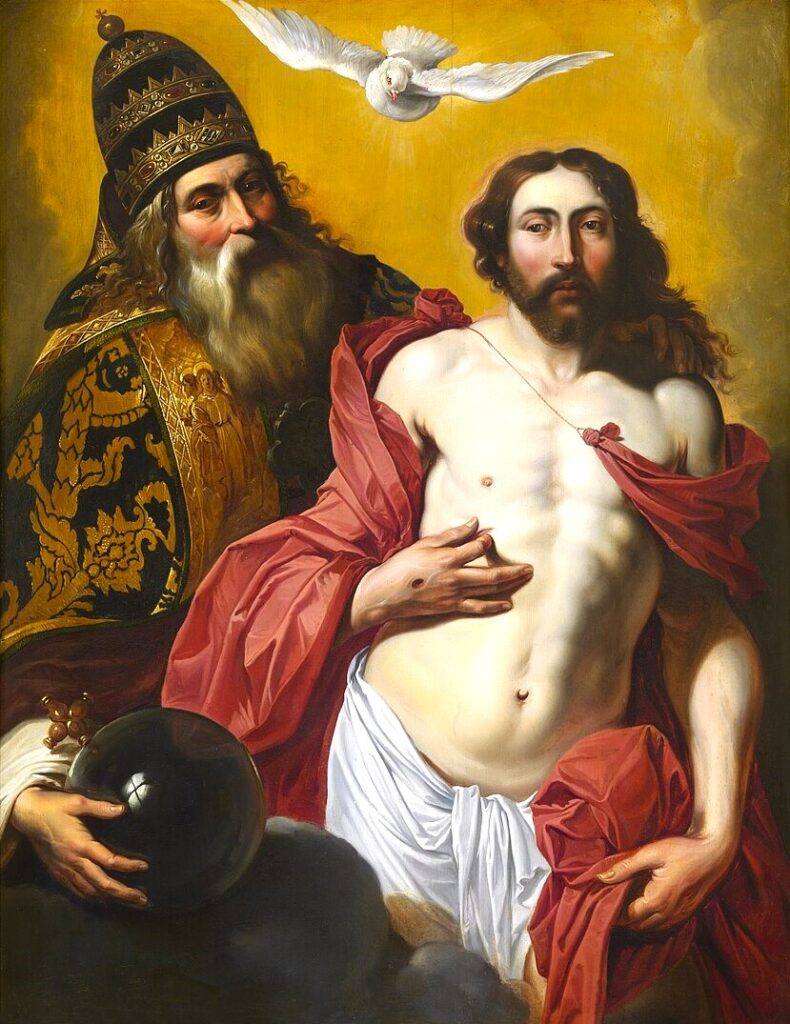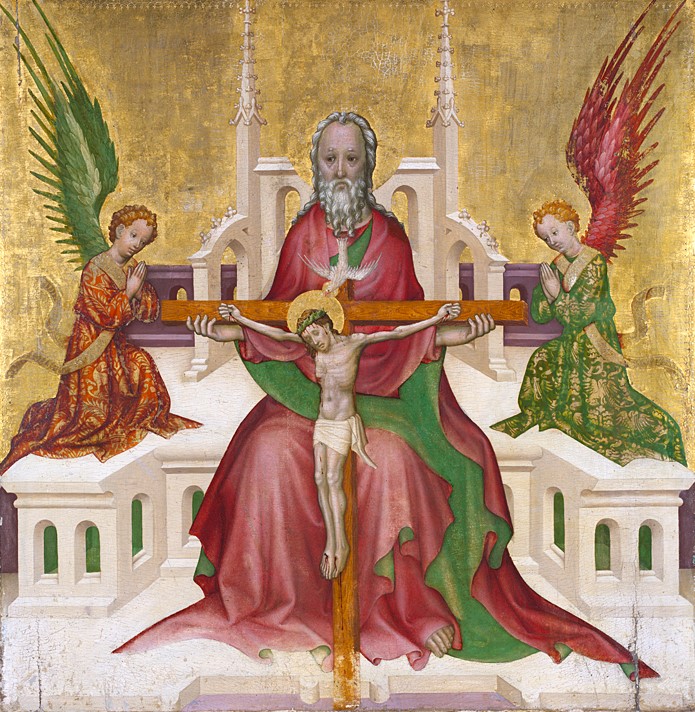
A Reading From the Gospel According to John
God so loved the world that he gave his only Son, so that everyone who believes in him might not perish but might have eternal life. For God did not send his Son into the world to condemn the world, but that the world might be saved through him. Whoever believes in him will not be condemned, but whoever does not believe has already been condemned, because he has not believed in the name of the only Son of God.
Transcription of Sermon
In the Name of the Father, and of the Son, and of the Holy Spirit. Amen.
Having finished the strong liturgical seasons, Advent, Christmas, Lent, and Easter Season, all of which marked parts or moments in the life of Our Lord’s earthly presence, the Church now focuses on mysteries of the Faith that are not necessarily bound up in temporal actions of Our Lord, but central mysteries of the Faith and today, obviously, it’s the Holy Trinity.
St. Augustine wrote an 800-page book De Trinitate, and, while he was writing it, he had a vision as he walked along the beach. And in this vision, he sees a little boy who’s dug a hole in the sand right near the seashore and is taking shells and filling the hole with water. And Augustine says, “What are you doing?” He said, “I’m putting the entire ocean into this hole.” And he said, “That’s impossible.” And the four- or five-year-old boy said, “And it’s also impossible for you to fit the Blessed Trinity into your mind.” So, at the end of his 800-page booklet, he decided that well…, ‘This is an inexhaustible mystery and nobody can really understand that anyway.’ So here I am going to explain it to you completely in eight minutes.
Augustine speaks in terms of mens, notitia sui, amor sui, so a mind, knowledge of itself, and then love of itself. And this is going to be then kind of the foundation for his Trinitarian doctrine, which is all bound up in relations. Relations. And since it is important to remember too, that the notion of a person was never even considered until the Church had to figure out how to express this One Triune God. And so, the whole notion of a person, divine person, angelic person, the human person, was born of the discussions.
How do we discuss a trinity? And, it’s in eternal relations. Some will say that the Jews were only talking about this one person, the Father, and then the Son somehow appears on the scene, kind of a surprise. Nonetheless, the Church Fathers wouldn’t agree with that because we see a number of references, sometimes indirect in the Old Testament, referring to God in threes: First of all, we have the plural in which Our Lord says, “Let us. Let us make man according to Our Image.” And, man has a certain created trinity, in that we are made according to God’s image and likeness. And, Augustine would say that this image and likeness is our own triune soul which has an intellect, a will, and a memory. None of them separate from each other, but yes distinct, of the same substance and not the same.
Well, if you think of the phrase, a thinker thinks of thought. What’s going on there? There’s one substance, which is the thinker thinking a thought, but the thinker is not the thought. The thinker is not thinking itself. The thought is generated by the thinker. It’s distinct from him but not separate. You are not a thought. You’re more than that. You’re not just a thinker. You’re more than that. You’re not just thinking you’re more than that. And so, God the Father, who is the mens, the mind, knows Himself, and with one complete, definitive, irrepeatable, eternal, no beginning no end, thought, the Logos. And this Logos is His Image of Himself. And obviously, when God thinks of Himself, nothing is lacking. He doesn’t forget to add an ingredient. Right? He is absolutely simple. And in His perfect simplicity, this thought of Himself, this image, this Logos, is so complete, so definite, so absolute, that it is generated from Him. And what is generated from Him is His Son. And this is where we get the notion of father and son, and this was a paternity and a filial relationship that has no beginning no end; it’s not chronological. There’s no beginning. There wasn’t just God, the Father, a sort of an Allah type of being who was alone, and then one day thought of Himself, okay, that’s not the way it is. This knowledge of self is eternal. It’s absolute, it’s complete. And, this notitia sui, this knowledge of Himself, this complete, divine person, the Son, the Logos, looks at the Father, and His look, is a loving gaze. And this loving gaze between the two is a gift of self and this gift of self is also so complete, so absolute, there’s nothing lacking in the gift, and that this gift therefore, is a divine person, the Holy Spirit. Fulton Sheen calls it a divine sigh, the sigh of two lovers that is so complete it’s a divine person.
Thomas Aquinas tells us that everything that exists relates with something else. Nothing exists in a silo, or in a vacuum. And that the grades of existence, such as rocks, plants, animals, humans, angels, God, the whole gradation of existing things has an increasingly spiritual and interior communicability of self. So, a rock communicates with the ground by leaving its impression. The rock communicates with a wall when you throw it against it. There’s a sound, there’s a mark on the wall, there is a splintering. Ok all of this is a communication of existing things, at a very low level, obviously. With plants there’s a communication with its locality. But then, there’s a deeper communication in dropping a seed to plant a new plant, which is an image of the original plant that dropped the seed. And then, we see something even more profound in animals.
You think of a cow who gives birth to a calf, and that this calf has been gestating in the womb of the cow now is born and has a life of its own. It looks like the mom and has emotions. Aristotle calls these animals emotions. It doesn’t have an intellect. It doesn’t have a will. It doesn’t really have a memory. It has an ability to associate things. But it doesn’t transcend itself. A cow can’t look at a raccoon and say, “You know, I’d really like to have the life of a raccoon. That just be a lot more fulfilling than this bovine existence I’ve been cursed with.” They can’t get out of themselves. A man, though, higher up on the scale of gradations of existence, we can transcend ourselves.
Thomas Aquinas calls this a reditio completa, a complete turning in on oneself. But this isn’t myopic; it’s not narcissistic. This turning in on oneself is the ability to spiritualize realities.
So, when I caught a trout in a river, I saw it, I communicated with it by ruining its lunch by giving it a hook instead of a fly. And, I communicate with him by pulling it out of the water, and I let it go. But I still carry the trout in my mind, right? I’ve spiritualized this reality. I’ve made an image of it. The trout is dead, swam away, or it’s eaten, or whatever, but the trout, the image of the trout remains in the mind. So, what have I done? I’ve spiritualized the fish.
Well, this is something that is proper to man. And so, therefore we can relate with ourselves as we transcend ourselves. We have a memory, we have an intellect, we have a will. We make choices. And when you are baptized, you are baptized into the Trinity and therefore, have an intimate, profound, communicability with Him who is relationship itself. God in His triune existence has elevated existence to something so primordial and elemental, that He shares with everything that exists as participating in that one thought, the Logos, but it’s more than that because our communicability with God is not the communicability of a rock, of a plant, of an animal.
Rather, He has invaded our souls to take up a dwelling within us to the life of grace, and that therefore, this life of grace, then, makes of us bearers of this mystery. Not just contemplaters of it. Not just thinkers thinking of thought, but infused with divine life that He shared with us. We have the triune existence within us, and, as much as we’re in a state of grace, and to commit a mortal sin, therefore, is to cease communication. It’s to cut communication lines with Him. It’s as, Augustine says, curvatus in se, homo curvatus, is the man who is so… we say in Spanish ensimismado, so myopic, so turned into himself, that he is kind of… it’s a narcissism that is incapable of relating with others. And so, that’s what… so this homo curvatus, this is the curved man. He’s like… we don’t look up. We don’t transcend ourselves. We are kind of getting ever smaller, ever smaller, curved, focusing on our navels. And the habit of that then, means a habit of broken communication.
And nonetheless, our Lord doesn’t let that be the last word. He calls us back to the triune life. He calls us back to grace. He calls us back to forgiveness. And He calls us back to relationship. Relationship to enjoy the relationship that was His, is His, and always will be His in the Holy Trinity.
In the Name of the Father, and of the Son, the Holy Ghost. Amen.
— Fr. Ermatinger.


